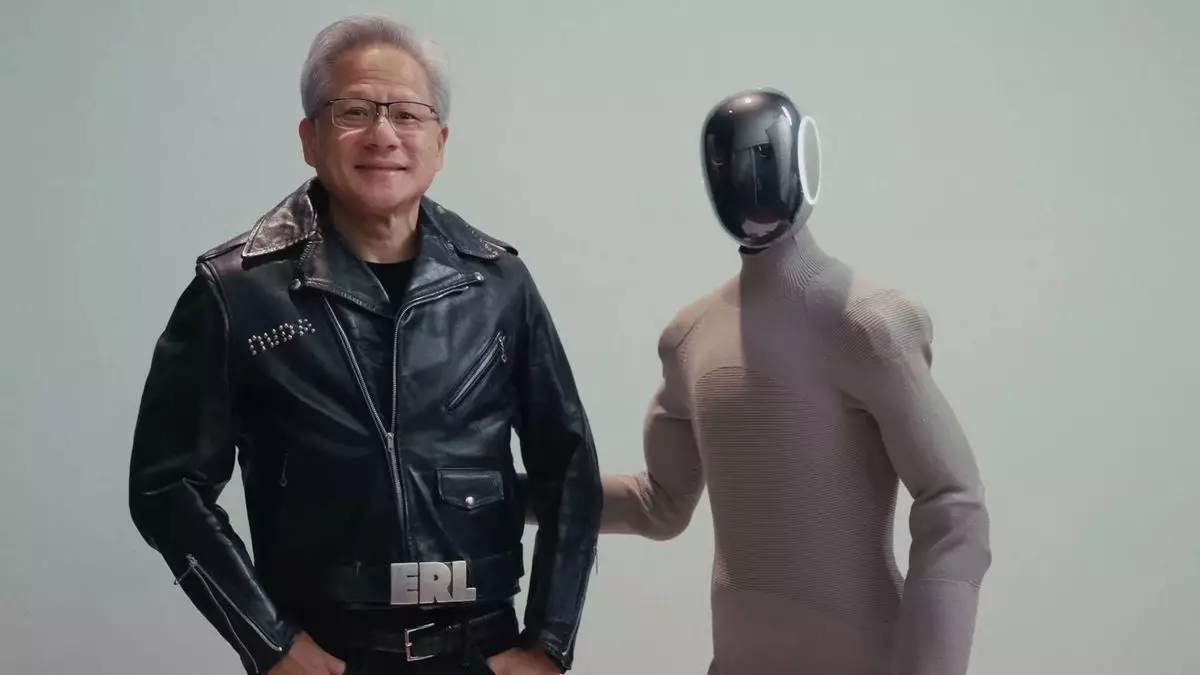In a recent, eye-catching event, Nvidia CEO Jensen Huang was presented with a unique gift: a studded leather jacket crafted by California’s ERL. This wasn’t merely a gesture of goodwill; it signified the partnership between 1X Technologies and Nvidia’s Gear Lab, whose animated humanoid robot, the Neo Gamma, is still in development. While the vibrancy of the event may have diverted attention from its deeper implications, it is evident that this collaborative effort seeks to merge the realms of robotics and daily life beyond surface aesthetics.
1X Technologies, originally founded in Norway as Halodi Robotics, rebranded in 2023 and has been pushing the boundaries of humanoid robotics. Being based partly in California, the firm’s focus on domestic and industrial applications reveals a broader ambition. The enthusiasm expressed by Eric Jang, 1X’s Vice President of AI, augments this drive: “We’re super determined to bring general-purpose humanoid robots into the world.” This forward-thinking approach is refreshing, but does it genuinely reflect the technological advancements being made, or is it merely optimistic rhetoric?
The Technical Framework of Cooperation
The partnership’s cornerstone is a joint venture aimed at refining the Neo Gamma’s autonomy capabilities. In a recent blog entry, the teams announced their initial project: preparing an autonomy demonstration for a keynote address at GTC 2025. This involved the robot performing a seemingly simple task: loading a dishwasher. However, take a moment to appreciate the complexity hidden within such operations. The collaboration has enabled Nvidia to access a dataset API that compiles various data collected from 1X offices and employee homes. This data is crucial for developing AI algorithms that allow the Neo Gamma to replicate human-like actions.
The workings of this partnership interface with the technology underpinning the Neo Gamma. The onboard Nvidia GPU facilitates real-time processing, functioning at a continuous 5 Hz vision-action loop, which is no small feat. However, numbers alone tell only part of the story. The real-world application of this technology is yet to be seen in a way that feels polished and truly functional. The demonstration of grasping a cup and placing it in a dishwasher, while impressive in theory, raises questions about the general applicability of such actions in everyday life.
The Reality of Implementing Humanoid Robotics
While technical capabilities are crucial, understanding the practical implications of humanoid robotics is perhaps even more essential. The fact that the Neo Gamma is currently undergoing supervised training in a real home environment is an encouraging step toward meaningful integration into households. Yet, the slightly awkward yet endearing performance during its trial, where the robot was seen unsteadily placing fragile items into the dishwasher, harks back to one fundamental question: how much can we genuinely expect from these machines in their current iteration?
Despite 1X Technologies promoting the robot’s multifaceted abilities through exciting visuals in promotional videos—showing it engaging in various domestic tasks—the skepticism around the practical utility of the Neo Gamma still lingers. The juxtaposition between artistic representation and the robot’s actual performance cannot be ignored. As we navigate the landscape of humanoid robotics, it is crucial to remain grounded and critically assess our expectations.
The Futuristic Landscape of Humanoid Robots
The ambition to create humanoid robots is not a new phenomenon. Figures like Elon Musk have ventured into this space, promoting innovations that echo sci-fi narratives. Yet menial tasks performed by robots, like pouring coffee or serving drinks, may be overshadowed by deeper implications of their presence in our homes. As robots like the Neo Gamma inch closer to functionality, the real discussion shifts toward societal roles, implications for employment, and ethical considerations.
While the promise of robots taking over dreary domestic chores is tantalizing, the present reality suggests that widespread adoption remains a dream. There’s an intricate balance to observe between aspiration and the state of current technology. Thus, while Huang’s GTC keynote may have showcased impressive AI capabilities, it also reflected a more significant characteristic of the evolving technology landscape.
In embracing innovation, we should navigate with a critical perspective, understanding that while technology can enhance lives, true integration into daily existence may take many more years of research, development, and testing. Amid the excitement generated by humanoid robots, it is crucial to maintain vigilance over the intricate relationship between humans and machines, ensuring that when these robots finally reach our homes, they do so as competent companions rather than awkward housemates.


Leave a Reply